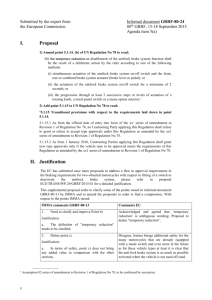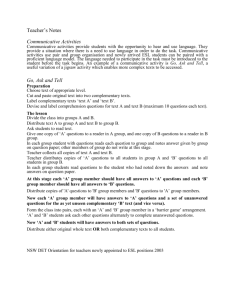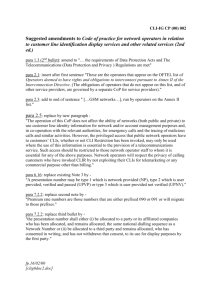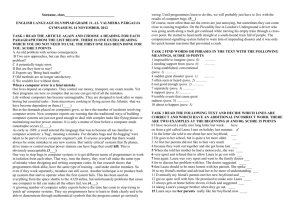India's comments on document: TRANS/WP.29/GRRF/2005/18
advertisement
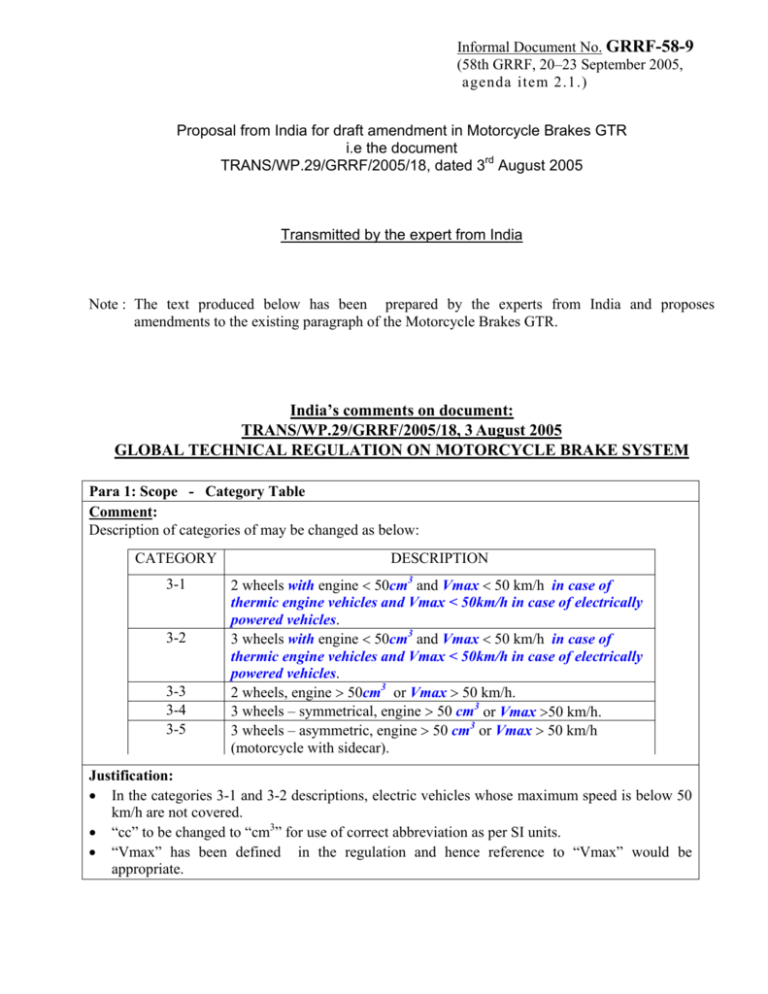
Informal Document No. GRRF-58-9 (58th GRRF, 20–23 September 2005, agenda item 2.1.) Proposal from India for draft amendment in Motorcycle Brakes GTR i.e the document TRANS/WP.29/GRRF/2005/18, dated 3rd August 2005 Transmitted by the expert from India Note : The text produced below has been prepared by the experts from India and proposes amendments to the existing paragraph of the Motorcycle Brakes GTR. India’s comments on document: TRANS/WP.29/GRRF/2005/18, 3 August 2005 GLOBAL TECHNICAL REGULATION ON MOTORCYCLE BRAKE SYSTEM Para 1: Scope - Category Table Comment: Description of categories of may be changed as below: CATEGORY DESCRIPTION 3-1 2 wheels with engine < 50cm3 and Vmax < 50 km/h in case of thermic engine vehicles and Vmax < 50km/h in case of electrically powered vehicles. 3 wheels with engine < 50cm3 and Vmax < 50 km/h in case of thermic engine vehicles and Vmax < 50km/h in case of electrically powered vehicles. 2 wheels, engine > 50cm3 or Vmax > 50 km/h. 3 wheels – symmetrical, engine > 50 cm3 or Vmax >50 km/h. 3 wheels – asymmetric, engine > 50 cm3 or Vmax > 50 km/h (motorcycle with sidecar). 3-2 3-3 3-4 3-5 Justification: • In the categories 3-1 and 3-2 descriptions, electric vehicles whose maximum speed is below 50 km/h are not covered. • “cc” to be changed to “cm3” for use of correct abbreviation as per SI units. • “Vmax” has been defined in the regulation and hence reference to “Vmax” would be appropriate. Para 2.4 Comment: In first Para, Category “3-2” may be changed to category “3-3” Justification: Editorial. Para 2.18 Comment: Unladen means, “mass in running order” taken from SR1, to which 75 kg is added to represent the mass of driver and instrumentation. Justification: There is a necessity to define the unladen mass to standardise the testing practice. New para 2.21 Comment: Average deceleration means the average deceleration calculated from either of the following formulae: Average deceleration = VI2/2S or Average deceleration = (VI- VJ)/(tJ-tI) or Average deceleration = 1 (tJ -tJ) tI ∫ a dt tJ Where: VI= Initial speed (m/sec) at initial time tI (Sec) VJ= Final speed (m/sec) at subsequent time tJ (Sec) S = Stopping distance (m) a= instantaneous deceleration at time t ( m/s2) Justification: In the tests referred under “Burnishing procedure (para 4.2.5), Wet brake stop (para 4.6.5), Heat fade test (para 4.7.3.1)”, the expression “vehicle deceleration” has been used. It is suggested that this term may be changed to average deceleration and a definition for this term should be provided for clarity. Para 3.1.2 Comment: The word “providing” may be changed to “provided” Justification: Editorial. 2 Para 3.1.4 Comment: This clause may be reworded as below: The two service braking devices may have a common brake so long as a failure in one braking does not affect the performance of the other. Certain parts such as the brake itself, the brake cylinders and their pistons (except for seals), the push rods and the cam assemblies of the brakes, shall not be regarded as liable to breakage if they are amply dimensioned, are readily accessible for maintenance and exhibit sufficient safety features. Justification: The condition prescribed in 3.1.4 should be applicable only when there are two separate service brake systems described in 3.1.3.1 The proposed text is in line with ECE 78. Para 3.1.5 Comment: The requirement in first para may be reworded as below: - have a separate reservoir for each brake system with its own cover, seal and retention or a single reservoir with partition for each brake system and a single cover, seal and retention. Justification: The safety requirements can be met, by a single container with partition. This would be a more cost effective alternative and hence may be permitted. Para 3.1.6 Comment: The first bullet point of 3.1.6 may be reworded as: - in the case of vehicles with Vmax > 60 km/h, if there is hydraulic failure when a maximum control force < 90N is applied; Justification: With split service hydraulic brake system, the failure in one system will not affect the performance of other system as per definition of “split service brake system” in this regulation. Low speed vehicles with Vmax < 60km/h, because of their low speeds, are easy to control with application of one service brake system in the event of a failure in one system, even if the failure of one system is perceived by the rider on actuation of brake control. In any case, a leakage type of failure which causes the fluid level to fall below the danger level would be indicated as per the requirements specified in the second bullet point of this para. Para 3.1.7 Comment: The word “amber warning lamp” may be changed to “yellow warning lamp”. Justification: In line with document TRANS/WP.29/2002/67/Rev.1. 3 Para 3.1.8. Comment: This Para may be reworded as below: Brake friction material shall not contain asbestos. However, asbestos-based friction materials may be used if permitted by national rule. Justification: Banning the use of asbestos only in the brake lining would not have any significant effect unless the use of asbestos is totally banned. Some of the countries have not banned use of asbestos. Hence it is felt that asbestos brake linings can be permitted in such countries. Para 3.4.2 Comment: Description for following terminology’s in the calculation of corrected stopping distance formulae may be changed as: Sa = measured stopping distance in meters Va = measured vehicle test speed in km/h. Note on “test speed within + 5km/h” may be converted into general requirement and may be added in para 4.1.4. Following requirement may be added at the end of this para: If actual weight of the vehicle at the time of test is different from specified values, the stopping distance or MFDD shall be corrected to the condition of specified mass by following formulae. S = (Sc –0.1Vs) x Ms/Mm +0.1Vs dm = dms x Mm/Ms where, S = stopping distance corrected to specified initial speed and mass (meters) Ms = specified mass (kg) Mm = actual mass at the test condition (kg) dm = Mean fully developed deceleration corrected to specified mass m/s2, and dms = measured mean fully developed deceleration m/s2. Justification: • The term “measured” is more appropriate in place of “actual” • The presence of note in this clause implies that variation in test speeds within + 5 km/h is permitted and the correction formula would apply. It is felt that when the stopping distance is measured, it is necessary to have a proper tolerance on the test speed. Incorporation of this requirement in para no 4.1.4 has been suggested accordingly. • Vehicle loading to the exact requirements would be difficult and time consuming. Permissible variation has been suggested for incorporation in para no 4.1.4. As the brake performance is directly proportional to the vehicle mass, it is suggested that this correction factor may be included for evaluating the brake system to specified conditions. Para 4.1.1.1 Comment: The value of PFC “0.9 or less” may be changed to “at least 0.9” Justification: Brake test has to be done with reasonable PFC. With a present wording, testing vehicles without ABS can be done even at 0.45 PFC which is not logical. 4 Para 4.1.1.4 Comment: Title may be changed to “Test Lane width” Justification: For better clarity, in line with terminology used in para nos. 4.9.6.2 and 4.9.4.2. Para 4.1.2 Comment: Ambient temperature condition “4° C and 38° C” may be changed to “4° C and 45° C” Justification: To cover test feasibility at higher temperatures in tropical countries such as India. Para 4.1.4 Comment: This clause may be reworded as below: During testing the following tolerance shall be applicable: • on the test speed shall be ± 5 km/h; • on the mass of vehicle ± 25 kg; • a general tolerance of ± 10% for other test parameters unless otherwise a tolerance or range is specified Justification: As explained earlier, the control of test speed and mass of the vehicle is very important for assessing the braking system. The tolerance suggested are what India feels as the best that can be achieved during testing. Para 4.1.6 Comment: The word “for the beginning” may be changed to “at the beginning” in the first line. Justification: Editorial. 5 Para 4.1.7 Comment: Test sequence table may be amended as below: Test order Paragraph 1. Dry Stop - single brake control activated 2. Dry Stop – all service brake controls activated 3. High Speed (as applicable) 4. If fitted: 4.1 Parking Brake 4.2 ABS 4.3 Partial failure, for split brake systems 4.4 Servo failure 4.3 4.4 4.5 4.8 4.9 4.10 4.11 5. Wet Brake (as applicable) (1) 6. Heat Fade (1) 4.6 4.7 Note 1/ may be modified as follows: 1/ Wet brake and Heat fade test shall always be the last tests carried out. Wet brake test shall be carried out before heat fade test. Care should be taken to ensure that the brakes are dry before start of the Heat fade test. Justification: High speed and Wet brake tests are applicable only in certain classes of vehicles and hence the suggested amendment provides better clarity. Since presence of moisture in the brake lining or pad may affect the heating of brakes, care is required to be taken to ensure that the brakes are dry before start of the Heat fade test. Para 4.2.2 Comment: This para may be amended as below: Tyre condition and tyre pressure: Tyres covered only 10 percent or less of their expected life shall be fitted on vehicle. The tyre depth measurement method may be used to assess tyre life. At the start of the test, tyre shall be cold and shall be inflated to pressure specified for respective load condition of the vehicle as given in manufacturers specification, Alternatively, The tyres shall be "run-in" prior to testing to remove compound nodules or other tyre pattern characteristics resulting from the moulding process. This will normally require the equivalent of about 100 km of normal use on the road. At the start of the test, tyre shall be cold and shall be inflated to pressure specified for respective load condition of the vehicle as given in manufacturers specification. Justification: • The suggested comments is to elaborate the “conditioning of Tyres”. • Alternate requirement specified would give more flexibility to decide tyre condition. 6 Para 4.2.3 Comment: Last para: Last word “pedal” to be changed to “pedal face” Justification: For better clarity. Para 4.2.5 Comment: Test speed: Initial speed : >50 km/h or 70% Vmax, whichever is lower. Final speed 5 to 10 km/h Vehicle Average deceleration: Front wheel braking only : 3.0 – 3.5 1.5 – 2.0 m/s2. Rest remains unchanged. Justification: • This is to cover 3-1 and 3-2 and other vehicles with maximum speed below 50 km/h. It is felt that in the case where the speed of 50km/h cannot be achieved, burnishing can be carried out at an initial test speed of 70% of maximum speed. It may also be noted that ECE 78 specifies 70% Vmax requirement for some of tests such as 10 repeated stops. • The use of expression vehicle deceleration does not convey the meaning whether it is the average deceleration or MFDD. It is felt that in the case of burnishing stops, specifying average deceleration is more appropriate. (Inclusion of definition for average deceleration has already been suggested in para no. 2.21.) • The deceleration value specified for front brake burnishing (3.0 – 3.5 m/s2) is too high because of following reasons. • MFDD performance requirements exceed 3.5 m/s2 only in the case of category 3-3 and 3.4. Hence in the other categories it would not be possible to achieve the presently specified deceleration during burnishing. • As per FMVSS 122, deceleration value during burnishing is approximately 54% of the limit value of total system effectiveness test. • There is no requirement of individual brake application during burnishing in FMVSS. • Hence India proposes to have vehicle deceleration 1.5 – 2.0 m/s2 for both front and rear brake application during burnishing in line with FMVSS. Para 4.3.2 Last para Comment: This requirement may be reworded as: For each stop, accelerate the vehicle to the test speed. For maintaining the initial test speed, gear suitable to that speed shall be used. During the braking, the throttle shall be fully closed and the engine shall be disconnected from the wheels by declutching or otherwise. If the vehicle is fitted with an automatic transmission, or if there is no manually operated gearbox, the throttle shall be fully closed. The brake control shall be activated under the conditions specified above. Justification: It is felt that the regulation should describe the test procedure to ensure that uniform practice is followed 7 Para 4.3.3. Comment: After a table, following note may be added: Note : If the above performance values specified for “single front brake only” cannot be achieved in case of categories 3-2, 3-3 and 3-4 because of limited adhesion, the following s shall be substituted for a test with the vehicle laden using both brakes together: - In the case of category 3-2, when tested as per procedure given in clause 4.4.3, the stopping distance S ≤ 0.1 V + V2/115 or MFDD is not less than 4.4 m/s2. In the case for categories 3-3 and 3-4 the conditions of clause 4.4.3 are satisfied. Justification: The requirement for front brake alone cannot be met because of limited front axle reaction in case of number of vehicles. The present values given in GTR aim at achieving the same in case of disc brake. In order to avoid this problem, ECE 78 also specifies this requirement on similar lines. This would be applicable to category 3-2, 3-3 and 3-4 vehicles, since two separate service brake systems are permitted as per para 3.1.3. Para 4.4.2 Comment: Modify as: Test speed:, 60 km/h or 0.9Vmax, whichever is lower, where Vmax < 125km/h 100 km/h or 0.9Vmax, whichever is lower, where Vmax >125km/h Justification: The prescribed test speed of 90% of Vmax would be very high for vehicles whose maximum speed i.e.Vmax < 125 km/h. ECE R 78 also specifies a test speed of 60 km/h. The proposed suggestion would however not change the MFDD or stopping distance requirement. The suggested speed will be more relevant to actual running conditions in India, for vehicles with Vmax < 125 km/h. Para 4.4.3 Comment: Modify as: When the brakes have been tested in accordance with the test procedure in 4.4.2, the stopping distance (S) or the MFDD shall be: [ ≤ 0.1 V + 0.0051V2 ] - S ≤ 0.1 V + V2/149 or MFDD 5.8 m/s2 in case of vehicles with Vmax < 125km/h - S ≤ 0.1 V + V2/196 or MFDD 7.5 m/s2 in case of vehicles with Vmax >125km/h (where V is the specified test speed in km/h and S is the required stopping distance in metres) Justification: • MFDD may be added as an alternate to stopping distance. • Separate requirement may be specified for vehicles with Vmax less than 125km/h and more than 125 km/h in line with our proposal on para 4.4.2. • As per FMVSS-122, calculated MFDD values would be the following: For test speeds upto 72km/h: 9.8m/s2 For test speeds 80-132 -km/h: 7.1m/s2 For test speeds 140 to 192km/h: 5.9 m/s2 The MFDD prescribed in the draft GTR of 7.5m/s2 at speed of 100km/h itself is higher than the calculated one as per FMVSS. With lower test speeds, an MFDD of 7.5 m/s2 would not be achievable and hence India suggests that for vehicles with Vmax less than 125km/h the MFDD prescribed in ECE R 78 8 may be followed. India also feels that even in the case of vehicles with Vmax more than 125km/h, MFDD of 5.8 can be adopted. The following Graph would substantiate the proposal The stopping distance specified in FMVSS 122 for different speeds for the test with both the brakes applied do not fit into an equation of 0.1V + KV2. It is found that reasonable fit is obtained if regression is done by splitting the test speed into different ranges. The results of this regression is shown in the following figure. stopping distance (FMVSS 122) MFDD= 5.9m/s/s Stopping distance (m) 300 250 200 MFDD= 7.1m/s/s 150 MFDD= 9.8m/s/s 100 50 0 0 50 100 150 200 Speed (km/h) For speed range Equation Regression Corresponding MFDD (m/s2) Coefficient 24 to 72 km/h 0.1V + V2/252.3 0.978 9.8 80 to 136 km/h 0.1V + V2/182.8 0.985 7.1 144 to 192 km/h 0.1V + V2/152.9 0.998 5.9 Values of MFDD above about m/s2 are difficult to achieve by design and compliance to stopping distance requirements specified in FMVSS depends largely on the riders skill in reducing the actuation time. Para 4.6.1 Comment: Following words may be added at the end of the third para: Drum brakes are exempt from this test unless open ventilation ports or open inspection ports are present, through which water ingress into the brake is possible. Justification: For better clarity. 9 Para 4.6.3 (1st para), 4.7.3.1 (4th para) Comment: First para: The words vehicle deceleration may be changed to “average deceleration”. Justification: For better clarity. Please also refer to our comments on new para 2.21. Para 4.6.4.1 b) Comment: After the words “After a distance of >500m” add the words “and not exceeding 600 m, with a water spray equipment still operating” Justification: It is felt that an upper limit need also to be specified to avoid difficulties at the time of testing and specifying condition of water spray equipment. Para 4.7.2.2 Comment: Test speed : 60km/h or 0.7Vmax whichever is lower. Justification: The proposal is in line with ECE 78, to take care of vehicles with low Vmax where 60km/h cannot be achieved. Para 4.8.3 Comment: Add following clause at the end of this para. In case, suitable specified gradient (18%) is not available, the test may be carries out on a nearest available gradient as per the following procedures: - Carry out the test on nearest available higher gradient as per the procedure given above and if the vehicle meets the requirements of being held, the vehicle shall be deemed to comply with the requirements of this regulation for parking brake. If the nearest higher gradient is not available, or the vehicle fails to meet requirement with nearest higher gradient with specified weight, establish maximum mass of vehicle, which the parking brake is capable - of holding the vehicle stationary. - The maximum mass of vehicle Mm, that can be held stationary by the parking brake on specified gradient shall be calculated as: Mm = MT (Rcosθt +Sinθt) (Rcosθs +Sinθs) where, Mm = maximum weight of vehicle that can be held on the specified gradient (18%), in kg. MT = maximum weight of vehicle that was held on a test gradient in kg. R = Coefficient of rolling resistance = 0.02. θt = tan-1 (Gt/100) Gt = percent gradient on which the test was carried out. θs = tan-1 (Gts/100) Gs = specified gradient (18%) - If the calculated Mm is not less than the maximum recommended mass for the vehicle or the combination as the case may be, the vehicle shall be deemed to comply with the requirements of this Regulation for parking brake. 10 Justification: The suggested proposal would take care of the test requirements when exact gradient is not available for the test. Para 4.10.1 Comment: In a first para the last word “systems” may be changed to “hydraulic systems” Justification: For better clarity. General Comment: Wherever the text such as 3-1, 3-2, 3-3, 3-4 & 3-5 are specified, use the words “category / categories” as appropriate. e.g. category 3-1. Justification: Editorial. ----- 11


